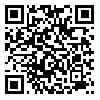Volume 18, Issue 2 (Vol.18, No.2, Summer 2022 2022)
irje 2022, 18(2): 104-115 |
Back to browse issues page
Download citation:
BibTeX | RIS | EndNote | Medlars | ProCite | Reference Manager | RefWorks
Send citation to:



BibTeX | RIS | EndNote | Medlars | ProCite | Reference Manager | RefWorks
Send citation to:
Haghdoost A, Alikhani A, Hosseini golkar M, Dehnavieh R, Seifi S. Scenarios of COVID-19 Epidemic Effects on Socioeconomic and Health Status of Iran. irje 2022; 18 (2) :104-115
URL: http://irje.tums.ac.ir/article-1-6630-en.html
URL: http://irje.tums.ac.ir/article-1-6630-en.html
AliAkbar Haghdoost1 
 , Alireza Alikhani *
, Alireza Alikhani * 
 2, Mostafa Hosseini golkar3
2, Mostafa Hosseini golkar3 
 , Reza Dehnavieh4
, Reza Dehnavieh4 
 , Samira Seifi5
, Samira Seifi5 


 , Alireza Alikhani *
, Alireza Alikhani * 
 2, Mostafa Hosseini golkar3
2, Mostafa Hosseini golkar3 
 , Reza Dehnavieh4
, Reza Dehnavieh4 
 , Samira Seifi5
, Samira Seifi5 

1- Professor of Epidemiology, Social Determinants of Health Research Center, Institute for Futures Studies in Health, Kerman University of Medical Sciences, Kerman, Iran
2- PhD Student of Futures Studies in Health, Department of Bio Statistics and Epidemiology, Faculty of Public Health, Kerman University of Medical Science, Kerman, Iran ,ar.alikhani@kums.ac.ir
3- Assistant Professor, Social Determinants of Health Research Center, Institute for Futures Studies in Health, Kerman University of Medical Sciences, Kerman, Iran
4- Associate Professor, Health Foresight and Innovation Research Center, Institute for Futures Studies in Health, Kerman University of Medical Sciences, Kerman, Iran
5- M.sc of Information Science, Department of Information Science, Razi University, Kermanshah, Iran
2- PhD Student of Futures Studies in Health, Department of Bio Statistics and Epidemiology, Faculty of Public Health, Kerman University of Medical Science, Kerman, Iran ,
3- Assistant Professor, Social Determinants of Health Research Center, Institute for Futures Studies in Health, Kerman University of Medical Sciences, Kerman, Iran
4- Associate Professor, Health Foresight and Innovation Research Center, Institute for Futures Studies in Health, Kerman University of Medical Sciences, Kerman, Iran
5- M.sc of Information Science, Department of Information Science, Razi University, Kermanshah, Iran
Abstract: (893 Views)
Background and Objectives: The COVID-19 epidemic and its subsequent effects have become a significant global challenge. In addition to being affected by this crisis, Iran is also facing many other problems, including sanctions and economic problems. So, there is a concern that it will suffer more severe consequences.
Methods: Scenario planning is one of the ways to recognize future changes and environmental uncertainties. This study used the so-called global business network (GBN) method, also known as the scenario matrix method. This method is based on two key uncertainties and six steps have been taken to examine variables related to health and socio-economic factors and use the opinions of relevant experts.
Results: To be expected, Iran's health system will be able to manage the epidemic in the face of various conditions with severity and weakness, and only in the pessimistic scenario or in Worst-case scenario with the default assumption of the continuation of sanctions and the spread of the epidemic. It leads to global restrictions, loss of foreign exchange reserves, loss of performance or collapse of the health system, increasing the number of deaths and diminishing the quality of life.
Conclusion: Regarding the COVID-19 epidemic and the existing background factors, scenarios of Iran’s health and economic conditions were narrated. Given the ability of the scenarios to understand the complexity and help in decision-making, it is considered a useful tool for policy makers to have a broader, comprehensive and reasonable look to achieve a correct consensus. This situation leads to the preservation and continuation of society health and conventional economic decisions.
Methods: Scenario planning is one of the ways to recognize future changes and environmental uncertainties. This study used the so-called global business network (GBN) method, also known as the scenario matrix method. This method is based on two key uncertainties and six steps have been taken to examine variables related to health and socio-economic factors and use the opinions of relevant experts.
Results: To be expected, Iran's health system will be able to manage the epidemic in the face of various conditions with severity and weakness, and only in the pessimistic scenario or in Worst-case scenario with the default assumption of the continuation of sanctions and the spread of the epidemic. It leads to global restrictions, loss of foreign exchange reserves, loss of performance or collapse of the health system, increasing the number of deaths and diminishing the quality of life.
Conclusion: Regarding the COVID-19 epidemic and the existing background factors, scenarios of Iran’s health and economic conditions were narrated. Given the ability of the scenarios to understand the complexity and help in decision-making, it is considered a useful tool for policy makers to have a broader, comprehensive and reasonable look to achieve a correct consensus. This situation leads to the preservation and continuation of society health and conventional economic decisions.
Type of Study: Research |
Subject:
Special
Received: 2020/11/17 | Accepted: 2022/09/1 | Published: 2022/09/1
Received: 2020/11/17 | Accepted: 2022/09/1 | Published: 2022/09/1
Send email to the article author
| Rights and permissions | |
 |
This work is licensed under a Creative Commons Attribution-NonCommercial 4.0 International License. |



